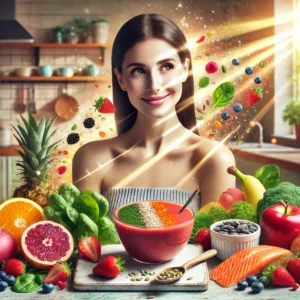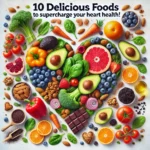Imagine looking in the mirror and seeing glowing, clear and youthful skin that looks as good as it looks. The truth is that getting glowing skin doesn’t have to mean applying expensive creams or following the latest beauty trends. It’s all about nourishing your skin from the inside out.
Your skin is a reflection of your overall health, and the food you eat plays a significant role in determining its texture, tone, and elasticity. In this comprehensive guide, we’ll take a deep dive into the science of how nutrition affects your skin, highlight the most powerful skin-nourishing foods, and give you actionable tips to help you achieve a naturally glowing complexion. Will provide steps.
The Food-Skin Connection
Our skin is our body’s largest organ, acting as a protective barrier as well as revealing signs of our internal health. When you nourish your body with nutrient-rich foods, your skin benefits. Conversely, poor dietary choices can speed up aging, increase acne and leave skin looking dull, lifeless.
How Food Affects Your Skin
- Promotes Hydration: Hydrated skin looks supple, healthy and glowing. Water-rich foods provide essential moisture to skin cells.
- Enhances Repair: Vitamins and minerals like vitamin C and zinc aid in collagen production and tissue repair, keeping the skin strong and youthful.
- Neutralizes Damage: Antioxidants combat oxidative stress from pollution and UV rays, preventing premature aging.
- Controls Inflammation: Anti-inflammatory nutrients help manage redness, acne and sensitivity.
Essential Nutrients for Glowing Skin
To glow from within, focus on including these nutrients in your daily diet:
1. Hydration Powerhouses
Hydration is the foundation of healthy skin. When your skin is dehydrated, it appears dull and is more prone to fine lines and wrinkles.
- Key Foods: Watermelon, cucumber, celery, oranges, tomatoes, and coconut water.
- Pro Tip: Start your day with a glass of lemon or mint water for an extra boost of hydration.
2. Antioxidants: Nature’s Defense Against Aging
Antioxidants protect skin cells from damage caused by free radicals, which can lead to wrinkles and age spots.
- Key Foods: Berries (blueberries, raspberries, strawberries), spinach, kale, green tea, and dark chocolate (70% cacao or higher).
- Research Insight: A study in Nutrients highlights that an antioxidant-rich diet improves skin texture, reduces inflammation and promotes healing.
3. Omega-3 Fatty Acids: Moisture Masters
Omega-3 fatty acids are essential for maintaining the skin’s lipid barrier, reducing inflammation and preventing dryness.
- Key Foods: Salmon, mackerel, walnuts, chia seeds, flaxseeds, and hemp seeds.
- Research Insight: Published in the Journal of Clinical Medicine, omega-3s have been linked to improved hydration, elasticity and reduced redness.
4. Collagen-Boosting Foods
Collagen is the protein responsible for the structure and firmness of the skin. As we age, collagen production decreases, but diet can help maintain its levels.
- Key Foods: Citrus fruits (oranges, lemons, limes), bell peppers, broccoli, bone broth, and tomatoes.
- Pro Tip: Combine vitamin C-rich foods with collagen-rich foods to increase absorption and effectiveness.
5. Vitamins and Minerals: Skin’s Superheroes
- Vitamin C: Supports collagen synthesis and brightens skin (kiwi, guava, strawberry).
- Vitamin E: Protects skin from UV damage and repairs skin barrier (almonds, sunflower seeds, avocado).
- Zinc: Controls oil production and reduces acne (pumpkin seeds, chickpeas, lentils).
- Vitamin A: Promotes cell turnover for a smoother complexion (carrots, sweet potatoes, spinach).
Foods to Avoid for Clear, Glowing Skin
While some foods boost skin health, others can cause inflammation, accelerate aging and disrupt your skin’s natural balance.
Refined Sugar
Why It’s Bad: Sugar causes glycation, a process that damages collagen and elastin, leading to wrinkles and loose skin.
Examples: Sodas, candies, pastries, and sugary cereals.
Pro Tip: Replace refined sugar with natural sweeteners like honey or dates.
Processed Foods
Why It’s Bad: High in unhealthy fats and preservatives, processed foods can clog pores and increase inflammation.
Examples: Packaged snacks, frozen meals, and instant noodles.
Dairy (if sensitive)
Why It’s Bad: For some people, dairy products may aggravate acne due to their hormonal content.
Examples: Milk, cheese, butter, and ice cream.
Excess Caffeine and Alcohol
Why It’s Bad: Both dehydrate the skin, making it look tired and dull.
Pro Tip: Limit your intake and hydrate well when consuming these beverages.
Practical Steps for Skin-Nourishing Eating Habits
Step 1: Create a Skin-Friendly Plate
- Half Plate: Colorful vegetables and fruits (rich in antioxidants).
- Quarter the Plate: Low-fat protein sources (lentils, chicken, fish).
- Quarter the Plate: Whole grains (quinoa, brown rice, oats).
Step 2: Include Healthy Fats
- Include a handful of nuts or seeds in your diet. Use olive oil or avocado as a dressing alternative.
Step 3: Stay Hydrated
- Aim to drink 2-3 liters of water daily. Add mint, cucumber or fruit pieces for taste.
Sample Meal Plan for Glowing Skin
Morning Routine
- Drink: Add a pinch of turmeric to warm lemon water.
- Breakfast: Smoothie bowl made with spinach, banana, blueberries, chia seeds and almond milk..
Mid-Morning Snack
- A handful of walnuts and a cup of green tea..
Lunch
- Grilled salmon or mixed green salad with tofu, quinoa, and olive oil and lemon dressing.
Afternoon Snack
- Fresh cucumber and carrot sticks with hummus.
Dinner
- Lentil soup with steamed broccoli and roasted sweet potatoes.
Evening Snack
- Herbal tea (chamomile or hibiscus) and a piece of dark chocolate.
The Science Behind the Glow
1. Hydration and Skin Elasticity
According to a study in Clinical, Cosmetic and Investigational Dermatology, proper hydration improves skin elasticity and reduces fine lines.
2. Antioxidants Fight Aging
Research published in Dermatology Research & Practice confirms that an antioxidant-rich diet helps reduce wrinkles and improve skin tone.
3. Omega-3s and Inflammation
Omega-3 fatty acids, as reported in the American Journal of Clinical Nutrition, reduce redness and enhance the skin’s natural glow.
Transform Your Skin in 30 Days
By consistently nourishing your body with skin-friendly foods, you’ll start seeing noticeable changes in just a month. Here’s how to make it happen:
- Start Small: Incorporate one new skin-friendly habit every week, like drinking an extra glass of water or adding a handful of nuts to your diet.
- Track Your Progress: Take weekly photos to track your skin’s improvement.
- Be Patient: Skin regeneration takes time, but consistency is key to achieving lasting results.
Final Thought: Glowing skin is more than a vanity goal – it’s a sign of a healthy, nourished body. When you prioritize nutritious, nutrient-rich foods, you will not only transform your skin but also boost your energy, confidence, and overall well-being.
So, what will you eat today to start your journey to radiant, glowing skin? Let the transformation begin!

